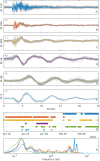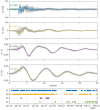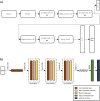Distributed dynamic strain sensing of very long period and long period events on telecom fiber-optic cables at Vulcano, Italy
- PMID: 36944784
- PMCID: PMC10030969
- DOI: 10.1038/s41598-023-31779-2
Distributed dynamic strain sensing of very long period and long period events on telecom fiber-optic cables at Vulcano, Italy
Abstract
Volcano-seismic signals can help for volcanic hazard estimation and eruption forecasting. However, the underlying mechanism for their low frequency components is still a matter of debate. Here, we show signatures of dynamic strain records from Distributed Acoustic Sensing in the low frequencies of volcanic signals at Vulcano Island, Italy. Signs of unrest have been observed since September 2021, with CO2 degassing and occurrence of long period and very long period events. We interrogated a fiber-optic telecommunication cable on-shore and off-shore linking Vulcano Island to Sicily. We explore various approaches to automatically detect seismo-volcanic events both adapting conventional algorithms and using machine learning techniques. During one month of acquisition, we found 1488 events with a great variety of waveforms composed of two main frequency bands (from 0.1 to 0.2 Hz and from 3 to 5 Hz) with various relative amplitudes. On the basis of spectral signature and family classification, we propose a model in which gas accumulates in the hydrothermal system and is released through a series of resonating fractures until the surface. Our findings demonstrate that fiber optic telecom cables in association with cutting-edge machine learning algorithms contribute to a better understanding and monitoring of volcanic hydrothermal systems.
© 2023. The Author(s).
Conflict of interest statement
The authors declare no competing interests.
Figures










References
-
- Neuberg, J., Luckett, R., Ripepe, M. & Braun, T. Highlights from a seismic broadband array on Stromboli Volcano. Geophys. Res. Lett.21,10.1029/94GL00377. issn: 0094–8276 (1994).
-
- Chouet, B. A. Seismic Model for the Source of Long-Period Events and Harmonic Tremor. In: Gasparini, P., Scarpa, R., Aki, K. (eds) Volcanic Seismology. IAVCEI Proceedings in Volcanology, vol 3. Springer, Berlin, Heidelberg. 10.1007/978-3-642-77008-1_11 (1992).
-
- Jousset P, Neuberg J, Jolly A. Modelling low-frequency volcanic earthquakes in a viscoelastic medium with topography. Geophys. J. Int. 2004 doi: 10.1111/j.1365-246X.2004.02411.x. - DOI
-
- Syahbana D, et al. Fluid dynamics beneath a wet volcano inferred from the complex frequencies of long-period (LP) events: An example from Papandayan volcano, West Java, Indonesia during the 2011 seismic unrest. J. Volcanol. Geothermal. Res. 2014;280:76–89. doi: 10.1016/j.jvolgeores.2014.05.005. - DOI
LinkOut - more resources
Full Text Sources
Miscellaneous

